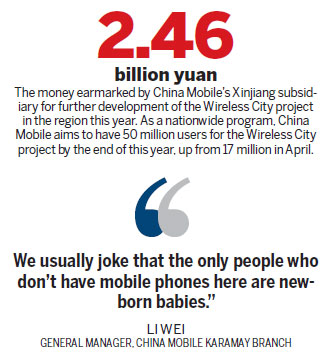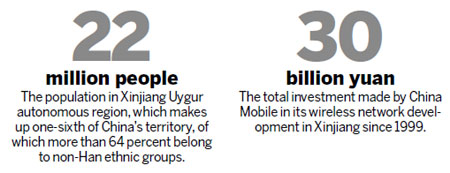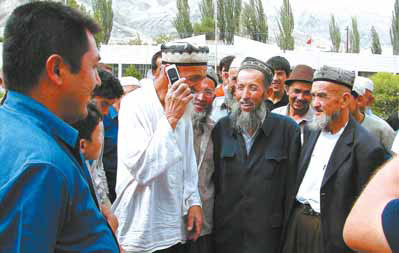Mobile technology lifts remote region
Updated: 2012-09-10 08:06
By Shen Jingting in Karamay, Xinjiang (China Daily)
|
|||||||||||
|
An elderly Uygur villager trying his new cellphone by calling his relatives. Xinjiang Uygur autonomous region is experiencing rapid change thanks to the introduction of mobile technology. China Mobile Ltd, the nation's biggest mobile operator by user base, has made a total investment of 30 billion yuan ($4.72 billion) in Xinjiang since 1999. The number of China Mobile's customers in Xinjiang reached 12.7 million by 2011, up almost 50 times over the past decade. Provided to China Daily |

Residents find their lives far easier thanks to living in a wireless world
Mobile Technology has not only revolutionized communication but has also helped people to lead a more efficient, greener and richer life in Northwest China's Xinjiang Uygur autonomous region.
Xinjiang, which occupies one sixth of China's territory, has a population of 22 million, of which more than 64 percent belong to non-Han ethnic groups. Although the region is rich in natural resources, has vast areas devoted to pasture and produces premium fruits, Xinjiang's economy is still lagging far behind those of many other provinces and regions, especially ones in China's coastal areas.
However, the autonomous region is experiencing rapid change thanks to the introduction of mobile technology. China Mobile Ltd, the nation's biggest mobile operator by user base, has made a total investment of 30 billion yuan ($4.72 billion) in Xinjiang since 1999. The number of China Mobile's customers in Xinjiang reached 12.7 million by 2011, up almost 50 times over the past decade.
Tens of thousands of mobile signal transmission towers have sprung up in Xinjiang, connecting people and helping the region get more closely involved in China's dynamic economic activities.
Wireless City
Karamay, an important oil industry hub in Junggar Basin, northern Xinjiang, was a barren land that supported very few creatures half a century ago. As more outside workers thronged to the city to explore the rich oil resources and creating an economic boom, Karamay developed into a modern and pleasant place and became the first wireless communications city in China's northwest regions.
The Wireless City project, which has been promoted by China Mobile since 2008, aims to provide the public with information and services on mobile terminals. It also aims to help improve the management of local government.
Walking the streets of Karamay today means walking amid an unseen web of 2G, 3G and Wi-Fi networks. Local residents can log on to the Wireless City website to enjoy nearly 50 types of urban information services covering government affairs, public utilities and personal life.
The mobile applications, which appear on the Wireless City portal wap.xjwxcs.com, provide all kinds of information an individual needs for everyday life, including real-time transport updates, shopping details, online restaurant reservations and payments for public utility bills.
"They (Wireless City applications) are very useful. First of all, I don't have to stand in the freezing weather for hours to wait for a bus now," said Wang Hu, a State-owned company worker in Karamay. In winter, when the temperature drops to -20 C, Wang searched for the specific bus he was about to ride on a mobile application.
He can find out immediately when the bus is due and leave home in time to meet it.
In Karamay, almost every bus station has an electronic screen telling people when buses are due to arrive. To enable this, the local government established a smart transportation system that embeds both a global positioning system and wireless technology. It is able to monitor public transportation, manage or dispatch taxis and release real-time information on the Wireless City website.
"The government built the system and offers the content. The content flows through the Wireless City portal and is available on people's mobile phones," said Wang Xiaokang, deputy manager of the group client department at China Mobile Karamay branch. This transportation service has greatly relieved traffic jams in the city and helped save people's time, he added.
Teachers can send messages from schools to parents via a mobile application, informing them how their children are behaving on campus and parents can respond immediately. Students have no need for cards at school because the mobile phone can help them complete various tasks, including buying meals and borrowing books. All it takes is a simple swipe of a mobile phone.
According to China Mobile, almost all the primary and middle schools in Karamay are connected to the Wireless City platform. More than 30,000 students, or 90 percent of the total, make use of the services.
When people are in need of certain out-of-stock medicines, they can turn to the Wireless City website and tap in the medicine name. They can soon find out which pharmacy is still selling the item and discover its exact location.
Wang said he and his colleagues hope one day the Wireless City portal will become an integral part of Karamay people's lives. "Every morning, when Karamay people get up, the first website he or she will open is the portal, checking things such as weather and transportation. The last web page he or she closes at night will be the portal as well," Wang said.
Although Karamay is a small city with a population of 400,000, the mobile phone penetration rate is about 170 percent, much higher than the nation's average of 70 percent, said Li Wei, general manager of China Mobile's Karamay branch.
"The figure indicates that every Karamay resident owns 1.7 mobile phones. We usually joke that the only people who don't have mobile phones here are newborn babies," Li said. The high usage rate of mobile phones in Karamay is evidence of the city's evolution into a wireless city. Meanwhile, the saturated market also offers impetus for telecom operators to launch in-depth services instead of merely competing for new customers, he added.
Since China Mobile started the Wireless City project in Xinjiang one year ago, 16 cities, including Urumqi, Karamay, Kashi and Altay, have launched similar city-level Wireless City online portals. The cumulative mobile application number has surpassed 700, with an active user base of 200,000 every day.
Bai Zhigang, general manager of China Mobile's Xinjiang subsidiary, said the company had earmarked 2.46 billion yuan this year to continue pushing forward the Wireless City project in the region. As a nationwide program, China Mobile aims to have 50 million users for the Wireless City project by the end of this year, up from 17 million in April.
The Internet of things
Xinjiang is China's largest cotton production base. It has about 24.7 million mu (about 1.6 million hectares) of cotton fields and is expected to produce 3.2 million tons of cotton this year, an estimated increase of 3.6 percent from last year, according to statistics from Xinjiang's development and reform commission. The production is about half of the total national cotton output.
Enough sunshine and appropriate irrigation are the two most important elements for a good cotton harvest. Sunshine is a natural blessing for Xinjiang people. However, the region faces severe water shortage problems, which requires an advanced irrigation system with a higher water utilization ratio.
China Mobile has launched pilot projects in Shihezi, a county in northern Xinjiang, involving automatic drip irrigation systems since 2009. Incorporated with the Internet of things technology, the system allows users to control irrigation through operating the switches of electromagnetic valves using mobile terminals.
The system can identify irrigation quantity and duration based on information it has gathered on soil dampness. It can also allow for the different irrigation requirements of crops and carry out integrated analysis of the weather, soil dampness, evaporation and rainfall to monitor the growth environment of crops.
Tang Yongzhu, 55, is among thousands of cotton farmers in Shihezi to adopt this irrigation system. Tang owns 60 mu of cotton fields that provide the only source of income for his family. By planting cotton, Tang supported his two sons to go to university and bought a new motorcycle this year. "The system has helped increase cotton production," Tang said as he carefully checked the cotton buds. The average yield has increased by 80 to 100 kilograms per mu under automatic drip irrigation, a delighted Tang added.
In addition, it saves labor since it takes a mere five hours for Tang to complete the irrigation of 60 mu of cotton fields compared with more than 24 hours previously, he said.
In Shihezi, automatic irrigation had been brought to nine farms with a total application area of 800,000 mu. By 2015 it is estimated more than 1.3 million mu will have it, said Su Jun, a local water-saving expert.
"The system is both efficient and low cost. To install it requires 750 yuan investment per mu. With the majority of the cost is subsidized by the local government, farmers only need to pay tens of yuan per mu," said Su. He added the irrigation technology is going to be promoted in the rest of the country. The technology was also exported to neighboring countries such as Kazakhstan and some African nations.
Information service
Zhai Xuejun, director of China Semi-Arid Agricultural Engineering Technology Research Center, said if the technology was applied in half of the wheat fields on the Chinese mainland, it would save 20 billion cubic meters of water a year.
"Then we can achieve the national target of increasing 50 million tons of grain output in just one year. It is of great significance in helping to ensure national food security and sustainable agricultural development," he said.
China Mobile has invested 35 million yuan in Xinjiang since 2007 to build up a rural information service. Farmers in Xinjiang receive free text messages on topics such as markets, technology and government policies, which helps them better understand national market trends, improve productivity and make better decisions.
Governments at all levels and farmers cooperatives can provide tailored information to local residents. There are nearly 800,000 users of the mobile rural information network in Xinjiang. A total of 1 billion messages about agriculture have been sent to farmers so far, involving a transaction volume of more than 50 million yuan, official data showed.
Ruoqiang county, southeast of the Taklimakan Desert, is home to fine quality sweet melons. Previously, because of transportation and communication problems, farmers often failed to find enough buyers and had to watch their crops rot in the fields.
Now the sweet melons are sold across the country and have even been exported overseas thanks to mobile technology. Local farmers have learned to establish brands in order to attract customer loyalty.
Liu Sanhai, founder of Xinjiang Sanhai Melon Patch Co, said he discussed business on the phone with dealers from Shanghai and Beijing from time to time. "The mobile phone helps me know about the outside world. In the meantime, I can send my sweet melon production information to customers and find out their needs," Liu said.
shenjingting@chinadaily.com.cn



(China Daily 09/10/2012 page13)
Today's Top News
President Xi confident in recovery from quake
H7N9 update: 104 cases, 21 deaths
Telecom workers restore links
Coal mine blast kills 18 in Jilin
Intl scholarship puts China on the map
More bird flu patients discharged
Gold loses sheen, but still a safe bet
US 'turns blind eye to human rights'
Hot Topics
Lunar probe , China growth forecasts, Emission rules get tougher, China seen through 'colored lens', International board,
Editor's Picks

|

|

|

|

|

|






